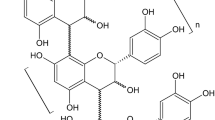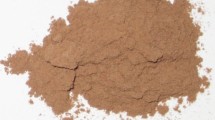Abstract
The principles of the use of tannins and resins extracted from wood bark have been known since the 1950's. But only in recent years research on tannins has become lively. The literature review at the beginning of this paper concentrates mainly on the latest investigations in this field. The experimental part investigates the amount and quality of spruce bark extracts and their suitability as extenders in plywood adhesives. The use of chemically treated bark (bark dispersion) in plywood gluing is studied in the last part. If spruce bark is extracted with distilled water, the extract yield is 11.2% at the most, but when 10% of NaOH is added the yield increases to 40.0%. The extract content of drum-debarked pulpwood bark was clearly lower than that of unfloated logs, debarked in the sawmill. The results obtained reinforce the earlier belief that spruce bark extract can substitute Quebracho as an extender for plywood adhesives. Bark dispersion can also be used for this purpose. Exterior-grade birch plywood can be manufactured, using glues which contain spruce bark extract and dispersion. The extract and dispersion can also substitute part of the phenolic resin in the glue mixture, up to 20% at best, without any deterioration in the quality of gluing.
Zusammenfassung
Die Prinzipien der Anwendung für aus Holzrinde gewonnene Extrakt-und Gerbstoffleime sind seit den fünfziger Jahren bekannt. Aber erst in den letzten Jahren ist die Forschung auf diesem Gebiet aktiver geworden. Die nachfolgend gegebene Literaturübersicht umfaßt deshalb in erster Linie neuere Untersuchungen. Im experimentellen Teil werden Menge. Qualität und Anwendbarkeit des aus Fichtenrinde gewonnenen Extraktes als Streckmittel für Sperrholzleime geschildert und die Anwendung von chemisch behandelter Rinde und Rindendispersion in der Sperrholzverleimung geklärt. Wird Fichtenrinde mit destilliertem Wasser behandelt, gewinnt man bestenfalls 11.2% Extrakt. Werden der Extraktlösung aber 10% NaOH zugesetzt, so steigt die Extraktmenge auf 40.0%. Der Extraktgehalt von mit Trommelentrindern entfernter Faserholzrinde ist deutlich geringer als der von im Sägewerk geschälter, nicht geflößeter Sägeblockrinde. Die Forschungsergebnisse bestätigen die frühere Ansicht, daß das Quebracho-Pulver, das als Streckmittel in den Sperrholzheimen verwendet wird, durch Fichterindenextrakt ersetzt werden kann: die Rindendispersion ist für denselben Zweck verwendbar. Mit Fichtenrindenextrakt und-dispersion enthaltenden Leimen läßt sich Birkensperrholz erzeugen, das die Anforderungen für Außenverwendung erfüllt. Mit Extrakt und Dispersion kann man günstigenfalls 20% des Phenolharzes der Leimmischung ersetzen, ohne daß die Verleimungsqualität sinkt.
Similar content being viewed by others
Literature
Clusters, A. J. L. 1979: Industrial application of wattle tannin/ureaformaldehyle fortified adhesives for damp-proof corrugated cardboard. Holzforsch. Holzverwert. 31 (6): 131–133
Coppens, H. A. 1980: Tannin formaldehyde adhesive for exterior grade plywood and particleboard manufacture. Forest Prod. J. 30 (4): 38–41
Hegert, H. L. 1969: Chemical composition of tannins and polyphenols from conifer wood and bark. Forest Prod. J. 10 (10): 610–617
Hemingway, R. W. 1978: Adhesives from southern pine bark. A review of past and current approaches to resin formulation problems. Complete Tree Utilization of Southern Pine. Edit. C. W. McMillin. Proceedings of a Symposium. New Orleans, Louisiana. April 1978
Hills, W. E.; Urbach, G. 1969: Reaction of polyphenols from conifer wood and bark. Forest Prod. J. 6 (10): 610–617
Kulvik, E. 1977: Chestriut wood tannin extract as cure accelerator for phenol formaldehyde wood adhesive. Adhesives Age 3:33–34
Liiri, O.; Sairanen, H.; Kipeläinen, H.; Kivistö, A. 1978: Puun kuoren käyttö liimojen raaka-ja jatkoaineina. (The use of bark as raw material and extender of adhesives) Espoo 1978, Valtion teknillinen tutkimuskeskus. Materiaali-ja prosessitekniikka. Julkaisu 3 (VTT Publication M3)
Norin, T.; Fremer, K.-E. 1977: Kuoren rakenne ja kemiallinen koostumus. (Structure and chemical compound of bark). Puukemia. Edit. W. Jensen. Helsinki
Pizzi, A. 1977: Hot-setting tannin-urea-formaldehyde exterior wood adhesive. Adhesives Age 12: 27–29
Pizzi, A. 1978: Utilizing wattle-based adhesive in making particle-board. Adhesive Age 9: 33
Pizzi, A. 1979a. Wood waterproofing and lignin crosslinking by means of chromium trioxide/quajacylunit complexes. Holzforsch. Holzverwert 31 (6): 128–130
Pizzi, A. 1979b: Phenolic and tannin-based adhesive resins by reactions of coordinated metal ligands I. Phenolic Chelates. J. Appl. Polym. Sci. 24: 1247–1255
Pizzi, A. 1979c: Phenolic and tannin-based adhesive resins by reactions of coordinated metal ligands II. Tannin adhesive preparation, characteristics and application. J. Appl. Polym. Sci. 24: 1257–1268
Plomley, K. F. 1959: The effect of soluble salts on the gelation of tannin-formaldehyde. Austral. J. Appl. Sci. 10: 494–497
Plomley, K. F.; Gottstein, I. W.; Hillis, W. E. 1964: Tannin-formaldehyde adhesives for wood I. Mangrove tannin adhesives. Austral. J. Appl. Sci. 15: 171–182
Plomley, K. F. 1966: Tannin-formaldehyde adhesives. CSIRO Division of Forest Products. Technological Paper 1966:46
Plomley, K. F. 1966a: Tannin formaldehyde adhesives for wood II. Wattle tannin adhesives. CSIRO Division of Forest Products. Melbourne. Technological Paper 39
U.S. Patent 2781327: Phenolic resin glue compositions containing modified bark phloem fluor. Ayers, J. W. & Bradley, J. J., 1957
Valtion teknillinen tutkimuskeskus Puulevylaboratorio 1974: Ureaja fenoliliimojen analyysiohjeita (Analytical methods for testing of ures-formaldehyde and phenolic resins.) Tiedonanto 6 (VTT/ PLE Report No. 6)
Author information
Authors and Affiliations
Rights and permissions
About this article
Cite this article
Liiri, O., Sairanen, H., Kilpeläinen, H. et al. Bark extractives from spruce as constituents of plywood bonding agents. Holz als Roh-und Werkstoff 40, 51–60 (1982). https://doi.org/10.1007/BF02612222
Issue Date:
DOI: https://doi.org/10.1007/BF02612222




